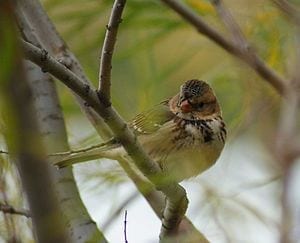
“As soon as the heat maps began to come out, everybody recognized this is a game changer in how we look at animal populations and their movement”
On a warm morning not long ago on the shore of a small prairie lake outside this state capital, Bob Martinka trained his spotting scope on a towering cottonwood tree heavy with blue heron nests. He counted a dozen of the tall, graceful birds and got out his smartphone, not to make a call but to type the number of birds and the species into an app that sent the information to researchers in New York.
Mr. Martinka, a retired state wildlife biologist and an avid bird-watcher, is part of the global ornithological network eBird. Several times a week he heads into the mountains to scan lakes, grasslands, even the local dump, and then reports his sightings to the Cornell Lab of Ornithology, a nonprofit organization based at Cornell University.
“I see rare gulls at the dump quite frequently,” Mr. Martinka said, scanning a giant mound of bird-covered trash.
Tens of thousands of birders are now what the lab calls “biological sensors,” turning their sightings into digital data by reporting where, when and how many of which species they see. Mr. Martinka’s sighting of a dozen herons is a tiny bit of information, but such bits, gathered in the millions, provide scientists with a very big picture: perhaps the first crowdsourced, real-time view of bird populations around the world.
Birds are notoriously hard to count. While stationary sensors can measure things like carbon dioxide levels and highway traffic, it takes people to note the type and number of birds in an area. Until the advent of eBird, which began collecting daily global data in 2002, so-called one-day counts were the only method.
While counts like the Audubon Christmas Bird Count and the Breeding Bird Survey bring a lot of people together on one day to make bird observations across the country, and are scientifically valuable, they are different because they don’t provide year-round data.
And eBird’s daily view of bird movements has yielded a vast increase in data — and a revelation for scientists. The most informative product is what scientists call a heat map: a striking image of the bird sightings represented in various shades of orange according to their density, moving through space and time across black maps. Now, more than 300 species have a heat map of their own.
The Latest Bing News on:
eBird
- Seeing Silicon | Cracking the case with eDNAon April 27, 2024 at 8:00 pm
Her fortnightly column will reflect on how emerging tech and science are reshaping society in Silicon Valley and beyond. Find her online with @shwetawrites. The views expressed are personal. Unlock a ...
- Eyes on the skies: Local birding experts share tips and tricks for their favorite outdoor hobbyon April 27, 2024 at 5:57 pm
On a walk through the neighborhood or a hike in the mountains, birds can be spotted just about anywhere. Sometimes it is a common crow and other times it’s an unfamiliar friend that offers ...
- BIRDING TODAY: Season marks perfect time to observe Warbleron April 27, 2024 at 3:00 pm
Warbler season has rolled around once again. It is time to begin getting ready to watch some of the most colorful birds this spring, so make sure you have plenty ...
- Hundreds of emotional bird lovers flocked to NY home to see rare lazuli bunting: ‘Birdwatcher’s bucket list’on April 27, 2024 at 2:24 pm
There was a lot to chirp about in this Long Island town. A lazuli bunting, known for living on the West Coast, visited the bird feeder at Meigan Madden Rocco’s Flanders, Long Island home to the ...
- Mid-Coast Audubon offers Sears Island Birding Field Tripon April 26, 2024 at 9:00 pm
Mid-Coast Audubon is set to lead a birding field trip to Sears Island in Searsport on Saturday, May 11. During spring migration, many songbird species rest and feed on Sears Island during their long ...
- Join the thrill of birdwatching at Homestead Park's ranger-led excursion on May 3 and 4on April 26, 2024 at 9:15 am
For people whoenjoy leisurely walks while being serenaded by elusive songbirds, Homestead National Historical Park's Education Center has the perfect activity ...
- A Beginner’s Guide to Birdingon April 26, 2024 at 9:04 am
Birding experts offer tips for new bird-watchers, from the best birding gear and apps to how to find your way into the bird-watching community.
- Flocking to Northwest Ohio? Here's what's new at the 2024 Biggest Week in American Birdingon April 26, 2024 at 2:13 am
Black Swamp Bird Observatory study suggested the event has a $37 million economic impact, a total now estimated to be nearer $40 million.
- We Are in the Golden Age of Bird-Watchingon April 25, 2024 at 7:45 am
We’re living in the golden age of birding, and like any good cult member, I’m recruiting people to the cause. I was reminded of how fortunate I am to be birding in these times on a recent work trip to ...
- What Bird Is That?on April 25, 2024 at 7:29 am
As someone who is interested in birds but doesn’t know a whole lot about them, this new animated video series from Will Ro ...
The Latest Google Headlines on:
eBird
[google_news title=”” keyword=”eBird” num_posts=”10″ blurb_length=”0″ show_thumb=”left”]
The Latest Bing News on:
Global ornithological network
- Experts call for global genetic warning system to combat the next pandemic and antimicrobial resistanceon April 25, 2024 at 2:00 am
The COVID-19 pandemic turned the world upside down. In fighting it, one of our most important weapons was genomic surveillance, based on whole genome sequencing, which collects all the genetic data of ...
- WHO calls for global detection networks for bird flu viruson April 24, 2024 at 1:08 pm
The World Health Organization (WHO) called Wednesday for a strengthening of global detection networks for the H5N1 bird flu virus which infected a large number of animal species.
- 10 of the best things to do in France for familieson April 22, 2024 at 9:10 am
Whether you choose an action-packed city break, an adventure in the mountains or relaxation in a rural gîte or by the beach, you’ll find France is a winner for family trips.
- Over AED 14.3 million provided to support global bird conservationon April 20, 2024 at 3:39 am
The Mohamed bin Zayed Species Conservation Fund MBZF has provided more than 390 grants of more than AED 143 million since its establishment to support the co ...
- Animals deserve to be included in global carbon cycle models as well, say researcherson April 16, 2024 at 9:58 am
Models of the global carbon cycle typically include plants, microbes, soil, and the atmosphere. But they may be leaving out an important variable: Animals, from earthworms to elephants, can have a ...
The Latest Google Headlines on:
Global ornithological network
[google_news title=”” keyword=”global ornithological network” num_posts=”10″ blurb_length=”0″ show_thumb=”left”]










